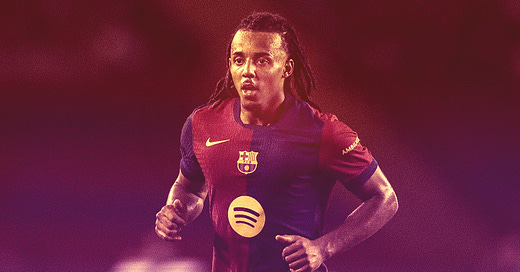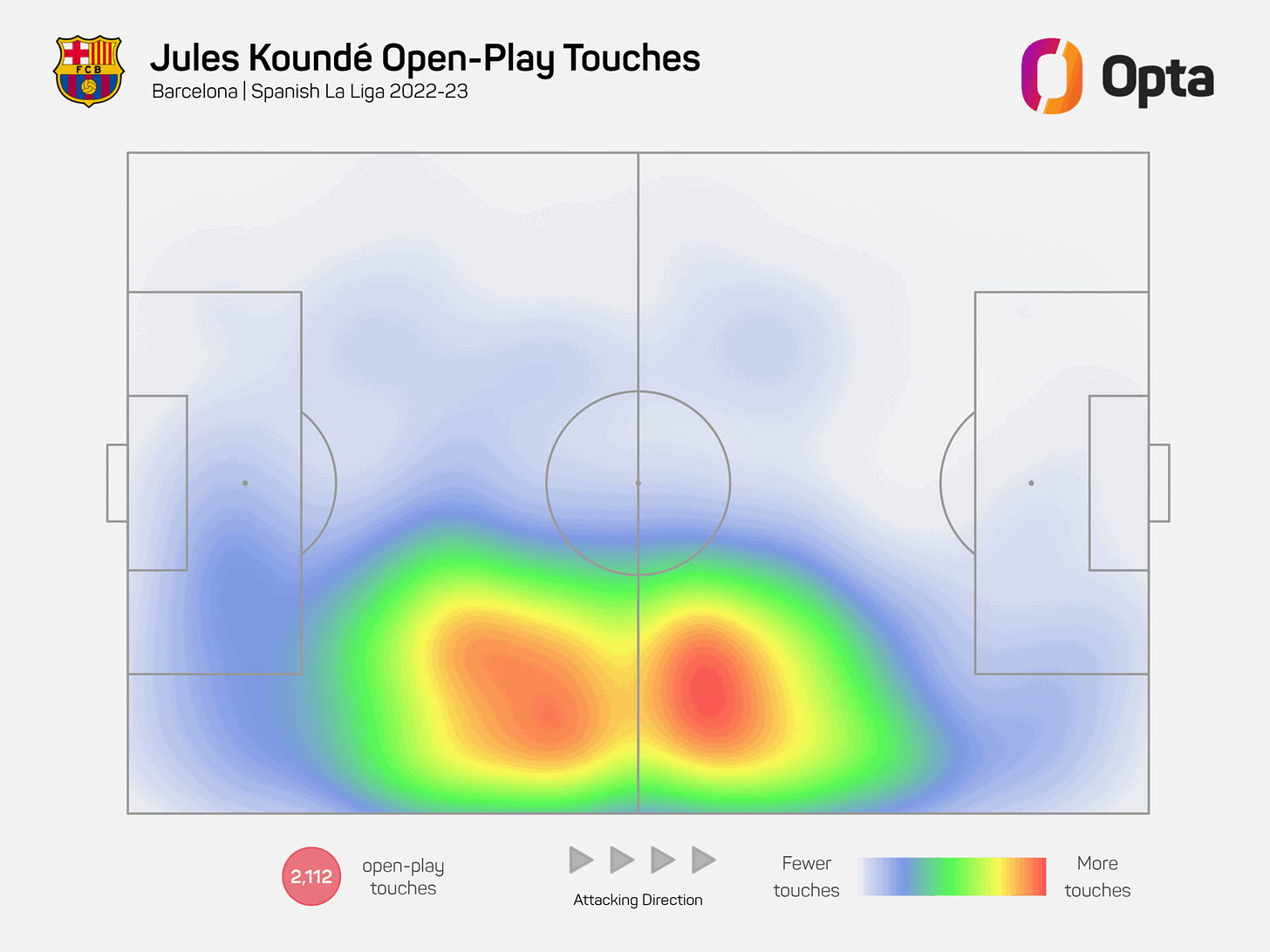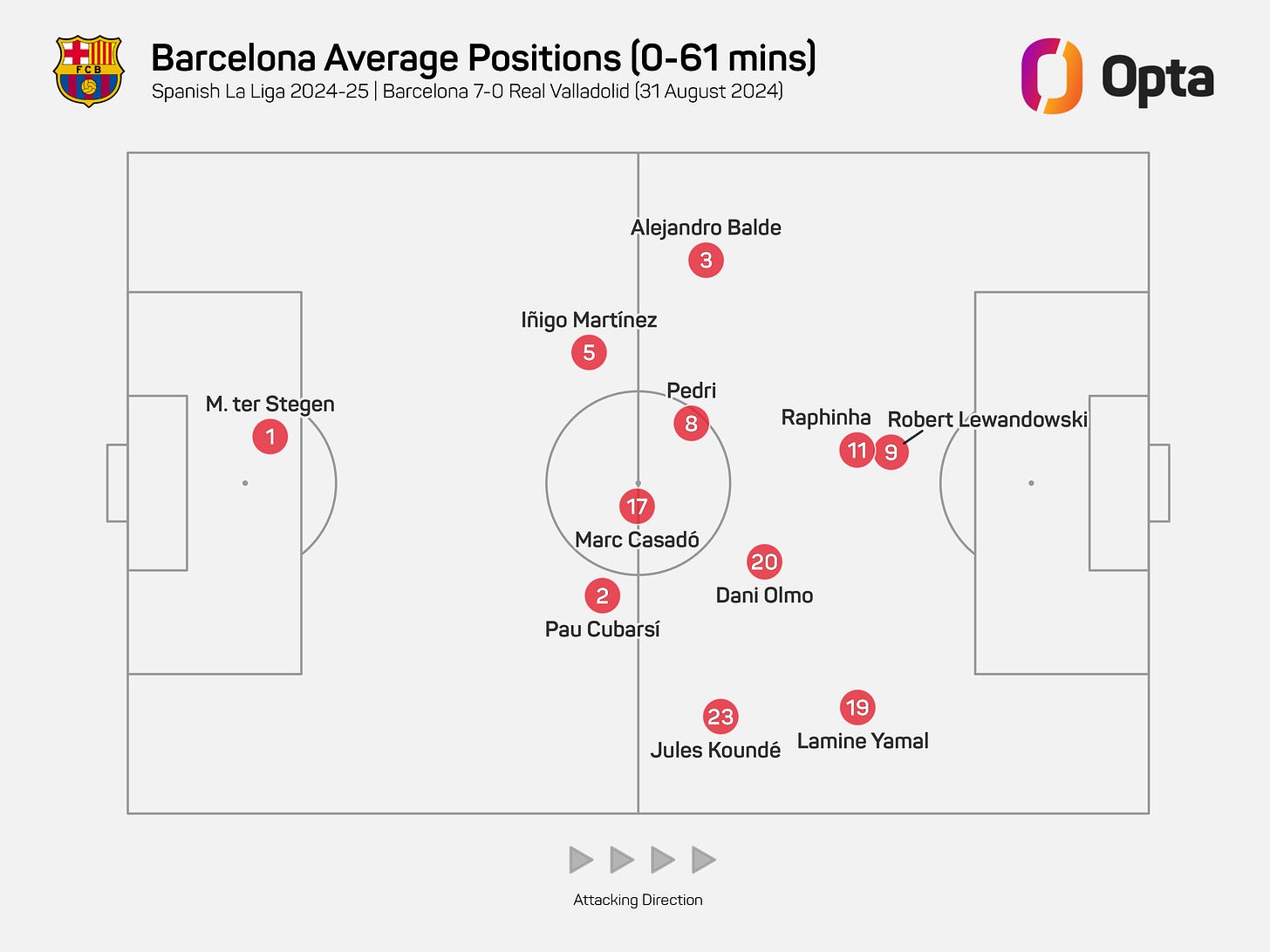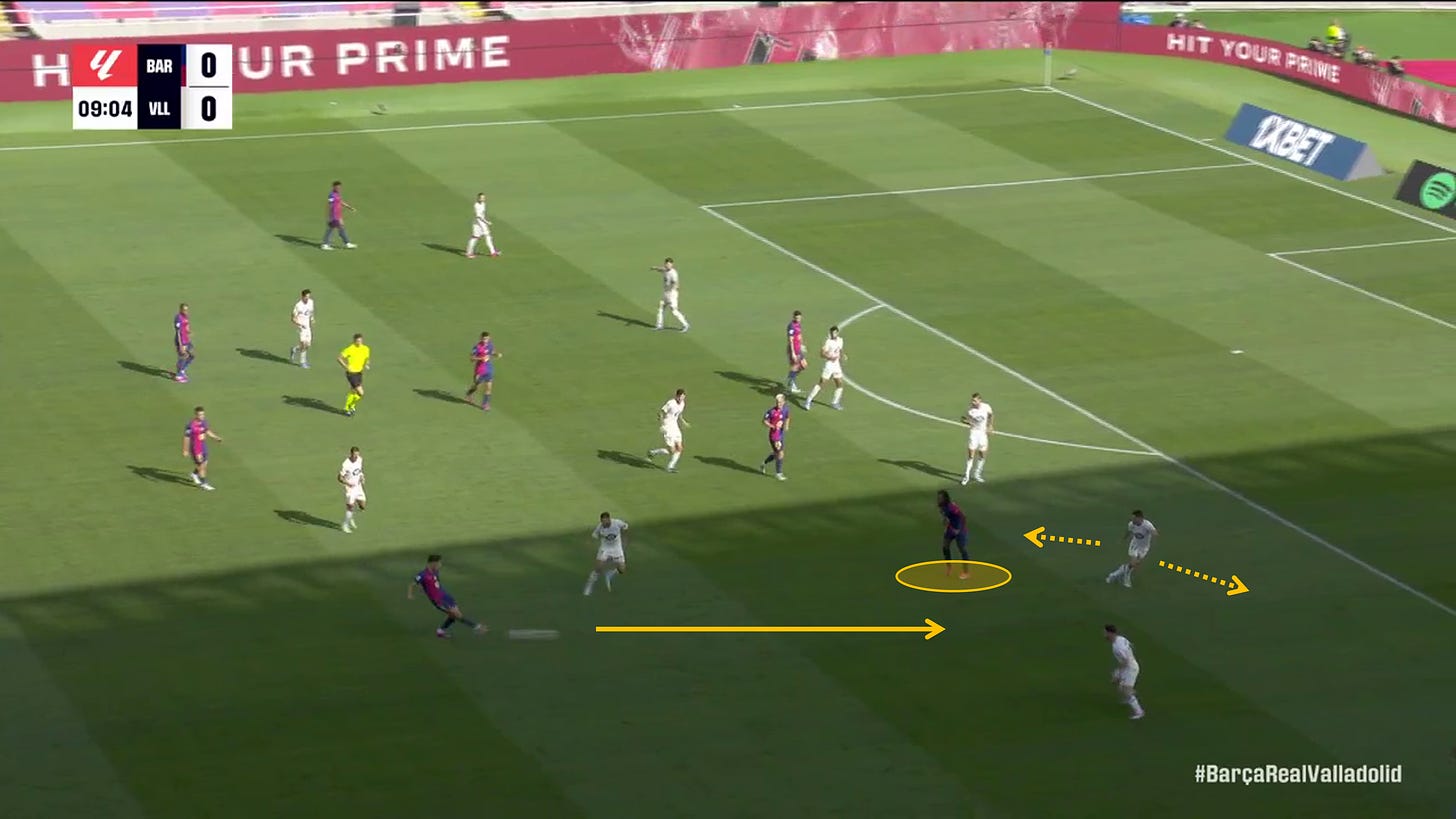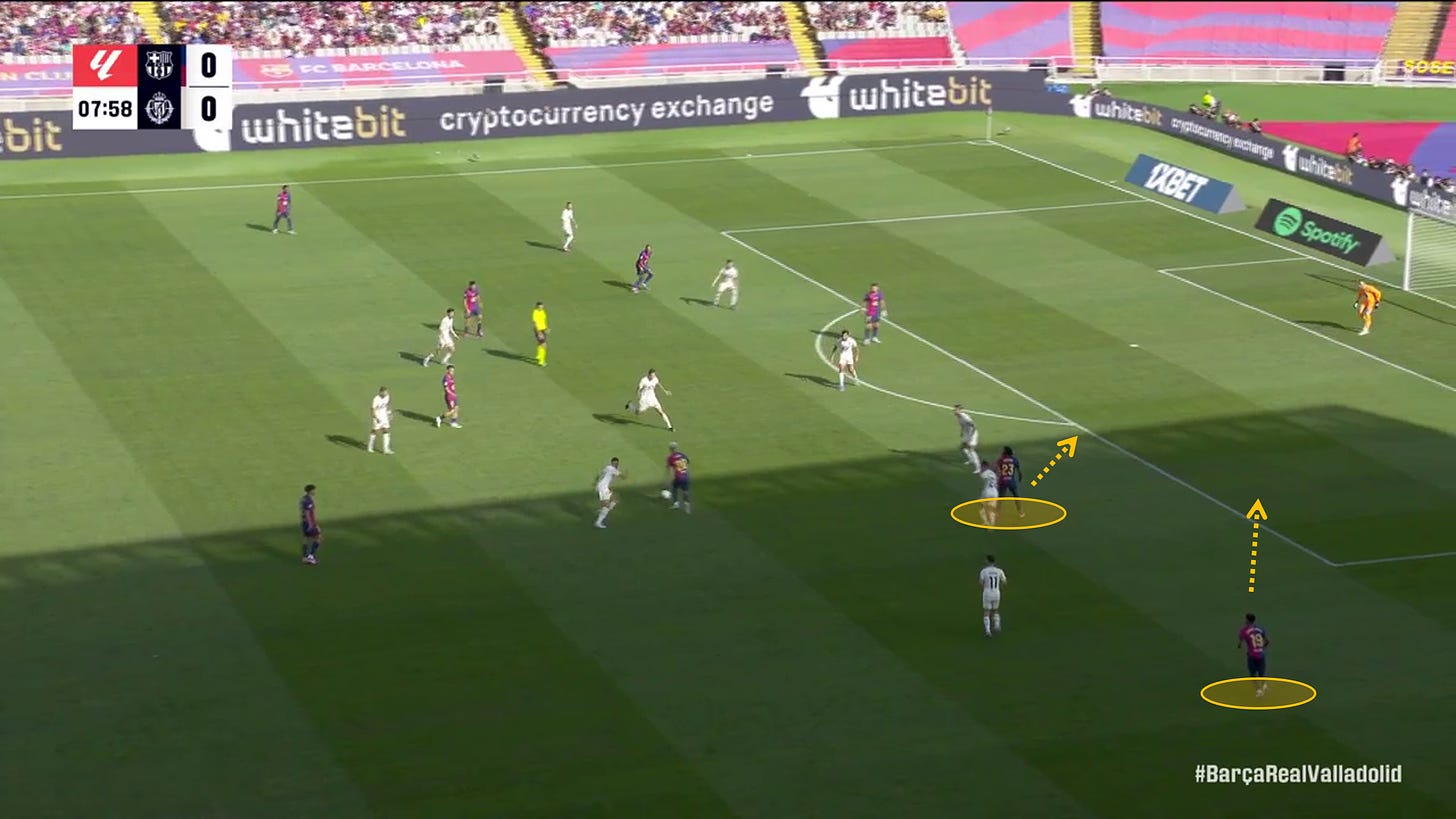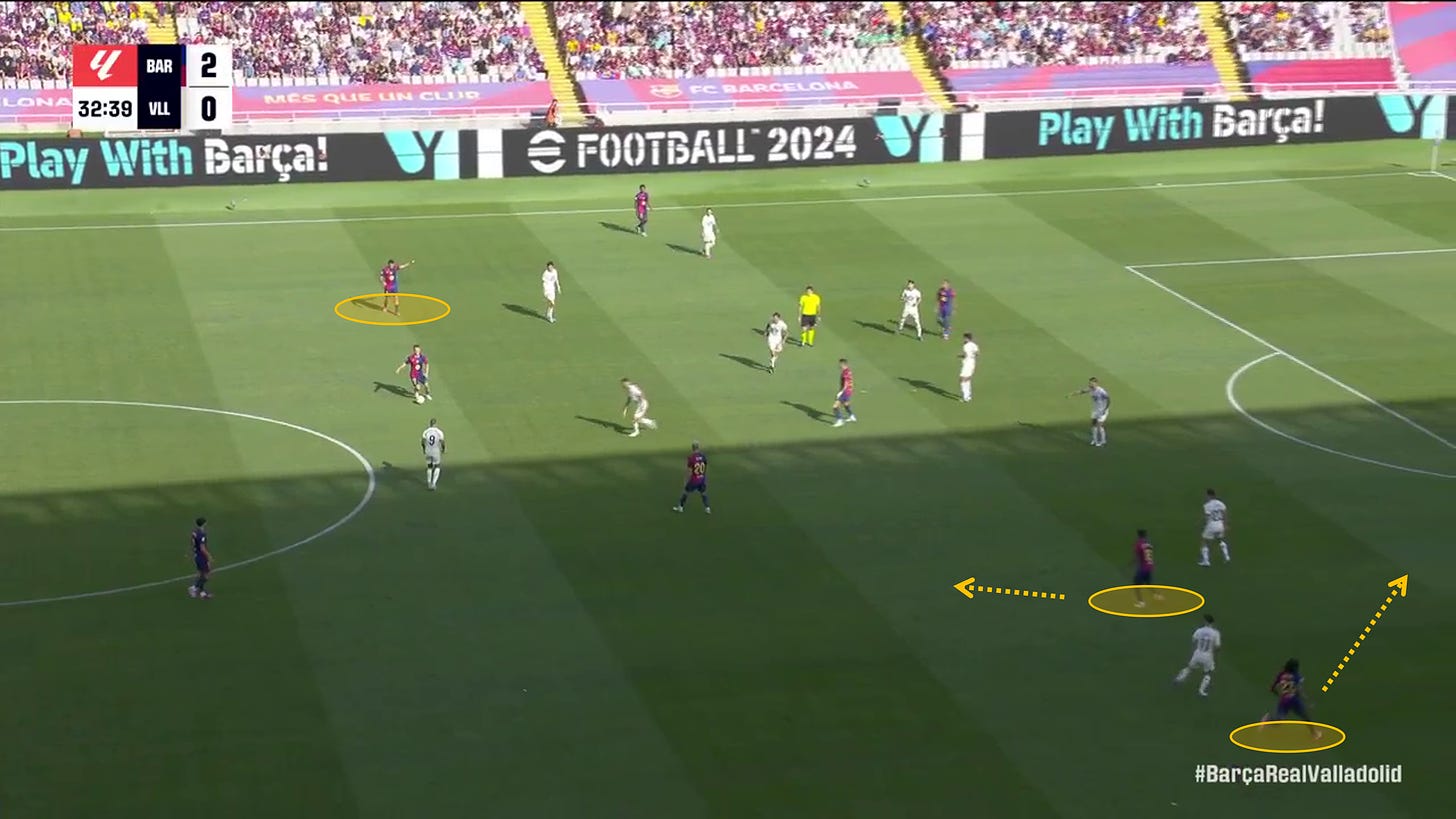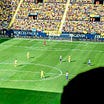Jules Koundé embraces his flipped script
The centre back Barcelona paid 63 million euros for in 2022 is thriving once more, albeit not in the way they had planned.
“I hated it for a while. When you’ve played centre back for 15 years, playing right back requires a completely different skillset.”
Over the past few years, Jules Koundé had always complied with his coach’s idea, but at the same time, rarely let the opportunities pass to make his preference known about his position.
I’ll do what I’m asked, but just remember I’m a centre back.
Whether it was a way to remove pressure from his performance in an unfamiliar role, or merely a reminder that his intention was to return to his natural position further down the line, his typical caveat made it clear he wasn’t all the way in. Even when Barcelona won the title in 2022-23 with Koundé featuring regularly at right back, something was still missing as far as his own satisfaction went.
Now, after a prolonged period of doubt, it seems like Koundé himself is the one closing the debate. Where and when exactly the switch was flipped is hard to tell, but between his performance levels and a renewed mindset — the crucial aspect that brings us to today — the once-reluctant right back is starting to look like a natural.
“I learnt to accept it. I think we block ourselves by being negative, which I may have been in the past,” he told Le Parisien earlier this summer, in regards to his positional switch.
“Nowadays, I feel more comfortable and take pleasure and working on the specific details of the role. I’m trying to improve, to be the best version of myself. It takes time, but I think people have already noticed improvement. I see it every day.”
No longer the third centre back
In learning to embrace his position, Koundé is shaking off the comfort blanket of being the third centre back. Tucking inside, acting as the deep cover for his winger, only really pushing into the opposition half to naturally shift up with play. Whether by instruction or natural approach, there had been a reticence to take on more than that – at least until recently.
Of course, fulfilling the role of third centre back is still very much part of his work for Barcelona. When you have Alejandro Baldé charging up the opposite wing as often as he does it’s a requisite role. As the year has developed, however, Koundé has begun to look like much more of an orthodox full back, expanding his range of input and rolling out new tools in the opposition half.
After four games, Miguel Gutierrez (12) is the only defender who has made more touches in the opposition box than the Frenchman (11), while his per 90 average of 2.8 is almost double that of last season as it stands.
From the process that began soon after arriving in 2022, Koundé’s gradual shift up the pitch is extending into his third season. And although Barcelona retain a left-sided bias when it comes to the more adventurous full back, the beginning of the Hansi Flick era has seen a less pronounced version from previous seasons.
In their 7-0 win against Valladolid last time out, Flick’s full backs were similarly aggressive in their positioning. Even with the left wing being occupied by Ferran Torres and later Raphinha – two players who end many attacks in central areas and open up the left flank in anticipation of Baldé’s arrival – Barcelona retained a symmetry from full back that has been missing in recent seasons.
That’s not to say Xavi was mistake before, or that Flick is the one who has seen the light. As Koundé has admitted himself, his own perception and struggle to embody being a true full back put a handicap on what he, as well as his coach, could previously expect to imagine. Between the player’s words and what we’re seeing on the pitch, it’s clear that the circumstances have changed, as have the possibilities.
Besides, there are no prizes for tactical symmetry. Hansi Flick isn’t interested in the shape of his team in itself, but rather its practicality. In their demolition of Valladolid, the way his side pulled their opposition apart and overwhelmed them in the final third had plenty to do with that balance on both sides.
Where opponents have long known to be vigilant of Baldé on the left, this newer, less predictable Koundé changes things.
Koundé’s adaptation chimes with Yamal’s explosion
The fleeting nature of transfers. You sign a player with an idea in mind, and then a whole raft of circumstances — many beyond your control or ability to imagine — take form and guide you down an entirely different path.
When the Catalans signed Jules Koundé in the summer of 2022, nobody was premeditating a full back conversion. Nor did they know that Lamine Yamal was close to arriving and would play ahead of him, before rapidly becoming one of the best in Europe in his position, aged 17.
Fortunately for Barcelona, they have been two significant developments for their present and future, particularly given their complimentary quality. And as Koundé goes about attacking his full back conversion, the implications for the club’s greatest asset are important.
It might seem like Yamal doesn’t need much help in navigating games and making his mark on play, but it’s up to his teammates and Hansi Flick to aid the conditions around him as much as possible. They need to move, occupy the right spaces, and make decisions that benefit the youngster, even if it’s not directly offering support or combining with him in wide areas. In the opening weeks of the season, we’ve seen just that from Koundé.
Here against Real Valladolid, it’s his movement inside that changes the face of the two-v-two match-up out wide, forcing full back Lucas Rosa to pull inside and take some focus away from Yamal. In the resulting gap, Pau Cubarsí punches one straight through to the young winger, attacking the box with a diagonal run (just out of picture).
Shortly before, Koundé had taken up a similar position but with the intention of running beyond the defensive line, splitting Javi Sánchez and Rosa. Had Dani Olmo turned out the other way after receiving his pass, there’s a good chance a player of his quality would have been able to pick the gap with a pass, guiding the Frenchman himself into a scoring position.
Even with Koundé’s run only turning out to be a decoy, however, he again manages to free up Yamal indirectly. As Rosa tucks inside to close the gap, the 17-year-old is primed to run off Raúl Moro should Olmo turn out towards goal.
Later on in the first half, we see Koundé switching up his movements inside with the classic overlapping run from full back. Dragging Moro back into the defensive third once more, his run again manages to achieve multiple effects.
The run is made as an attempt to get beyond the defence, and had a good chance of coming off had Marc Casadó been able to see and execute the pass (Pedri did his best to help). But regardless of a missed opportunity, Koundé’s appreciation of Yamal’s availability is again on show, with his movement timed to match the youngster’s own intentions. Seeing Yamal has no plans to run in behind himself, Koundé takes up the responsibility to contrast Yamal’s movement towards the ball and clear some extra space for him to receive.
With a talent as pronounced as Yamal ahead of him, it’s not a necessity for Koundé to develop a partnership as far as specific combinations go. Moving away from being the third centre back and incorporating himself into more attacks – even if only to serve Yamal, distract markers, and change the way opponents are defending him – is a crucial aspect though. And based on what we’ve seen so far this term, there’s a clear recognition of it in process.
Particularly given the new management and style of play that’s coming into effect, it’s still early days for knowing how far Koundé can take his attacking game from full back. With more proximity in the final third, a better understanding of his attacking capacity, and more game time with Yamal as the season develops, Barcelona stand to benefit plenty if his service of Yamal can become a genuine synergy.
Full back with a centre back’s resistance
Using natural centre backs at full back — or more accurately, turning centre backs into something resembling full backs — is no new revelation. One only need look at the current title challengers in the Premier League to see the trend at the height of the game.
If you can get an extra centre back on the pitch, without anyone being able to notice there’s a centre back playing ‘out of position’, the rewards are crucial for detail-oriented managers. You’re better at set pieces, you’re better at defending crosses, you remove a potential weak spot with balls to the back post, and more generally, you’re going to nudge up your collective ability to win individual duels.
While Koundé has had his ups and downs as a Barcelona player, a healthy and focused version of the Parisian is a formidable defender. Whether he’s playing as a right back or a centre back, for Barcelona or France, we know what his top end performances look like.
At the EUROs in the summer, France’s route in the knockout stages took them past Belgium and Portugal, before falling against Spain in the semi-final. For Koundé at right back, that meant match-ups with three premier wide players in Jérémy Doku, Rafael Leão and Nico Williams along the way.
Across those three games, Koundé faced a total of 11 take-on attempts and only lost the duel on four occasions (36%). He also ended the tournament with the joint-most tackles made by a defender (18). While his adaptation at full back for club and country had been difficult and often stagnant in an offensive sense, the 25-year-old has always had the raw materials to defend as a full back, and not just survive as a third centre back who has to fill out a line of four.
The example above comes against Raúl Moro — one of the standout dribblers in LaLiga so far this season — from Barcelona’s most recent game. Although there’s a late helping hand from Dani Olmo to close the door, Koundé’s footwork keeps him every step of the way with Moro, never once looking out of control or off balance while moving backwards the best part of 30 yards. Of the eight times an opponent has tried to take him on in LaLiga this term, only one has succeeded (13%).
For a big-bodied full back, the 25-year-old has a gift for moving in step with opposition dribblers and the changing direction of attacks — especially for someone who had been a central defender for the large majority of his career. Unlike many centre halves we’ve seen trialled as full backs around Europe, whether by design or necessity filling in the position, Koundé defends with an agility that masks his prior positional history.
Here he is against Valencia on MD1, sealing off the speedy Jesús Vázquez’s attempts to overlap, before recovering back out to shut down Diego López’s cross in the same sequence. In the types of dynamic attacks where centre backs playing at full back might otherwise struggle, given the natural limitations of defending on the move and with sharp changes of direction, Koundé defends with the light-footedness of a full back.
On his winding road from centre back standout, to reluctant full back, and now to engaged full back, there’s evidently a big element of mindset that has both blocked and cleared the path at varying times. In finding his way back to the latter, Koundé has banished the feeling that having to play at right back is a sacrifice and turned it into a personal challenge from which he can grow.
It's not that the Frenchman’s expanding attacking game from full back is standing out across LaLiga, or threatening to make him an individual offensive force, as if he were a hologram of Dani Alves connecting with his own Lionel Messi in Lamine Yamal. It’s that his conversion to full back is beginning to look both complete and varied – and with more likely to follow – from a player of his natural defensive stock.
In Hansi Flick’s Barcelona, a team who want to dominate not only through attacking football, but through a renewed physical force behind it, a Jules Koundé now raging against a development he once had no appetite for is a highly welcome ally.
By Jamie Kemp (@jamiemkemp)


